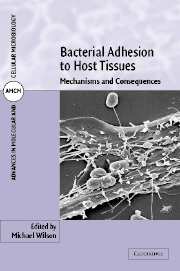Book contents
- Frontmatter
- Contents
- List of contributors
- Preface
- Part I Bacterial adhesins and adhesive structures
- Part II Effect of adhesion on bacterial structure and function
- 7 Transcriptional regulation of meningococcal gene expression upon adhesion to target cells
- 8 Induction of protein secretion by Yersinia enterocolitica through contact with eukaryotic cells
- 9 Functional modulation of pathogenic bacteria upon contact with host target cells
- Part III Consequences of bacterial adhesion for the host
- Index
- Plate section
9 - Functional modulation of pathogenic bacteria upon contact with host target cells
Published online by Cambridge University Press: 08 October 2009
- Frontmatter
- Contents
- List of contributors
- Preface
- Part I Bacterial adhesins and adhesive structures
- Part II Effect of adhesion on bacterial structure and function
- 7 Transcriptional regulation of meningococcal gene expression upon adhesion to target cells
- 8 Induction of protein secretion by Yersinia enterocolitica through contact with eukaryotic cells
- 9 Functional modulation of pathogenic bacteria upon contact with host target cells
- Part III Consequences of bacterial adhesion for the host
- Index
- Plate section
Summary
INTRODUCTION
The list of prokaryotic microorganisms able to cause illness or death in animals and plants is long. In fact, infectious diseases constitute the most common cause of human morbidity and death in the world. Our fight against these pathogens, however, started to become a serious scientific business only in our very recent history. The experience gathered during the past century has already demonstrated that even the initial hopes of the antibiotic era, namely to save uncountable lives by eradicating or limiting bacterial infections, turned out to be idealistic dreams of a scientific generation rather than deliverable promises. We now realize that the concept of either a pathogen-free world or the existence of a universally active therapeutic tool belongs to the realms of science fiction.
The treatment of infected patients has been rendered complicated by the constant emergence of multidrug-resistant strains. This is further impaired by the appearance of novel infectious agents that are not treatable by conventional therapies. Although it is expected that, as a result of the combined efforts of pharmaceutical companies, we will see new antibiotics coming onto the market, it has become clear that this strategy to combat pathogenic bacteria is insufficient and has limited value. In fact, a single point mutation in a gene from a member of the microbial community can destroy the outcome of many years of research and development. The identification of novel molecular targets for therapeutic intervention, in combination with high throughput screening for novel active compounds, will have a key role in the discovery of new tools to address these problems.
- Type
- Chapter
- Information
- Bacterial Adhesion to Host TissuesMechanisms and Consequences, pp. 203 - 220Publisher: Cambridge University PressPrint publication year: 2002
- 1
- Cited by



